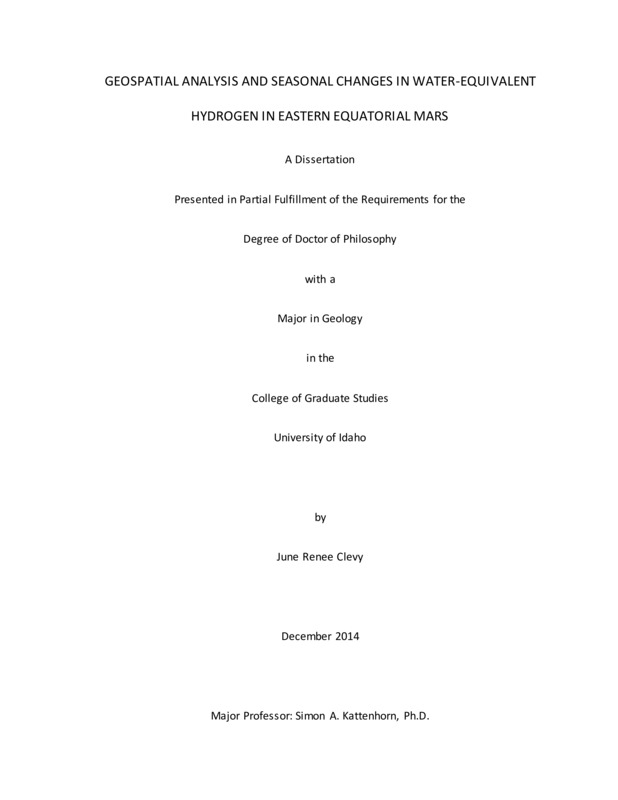Geospatial Analysis and Seasonal Changes in Water-Equivalent Hydrogen in Eastern Equatorial Mars
Clevy, June Renee. (2014). Geospatial Analysis and Seasonal Changes in Water-Equivalent Hydrogen in Eastern Equatorial Mars. Theses and Dissertations Collection, University of Idaho Library Digital Collections. https://www.lib.uidaho.edu/digital/etd/items/clevy_idaho_0089e_10282.html
- Title:
- Geospatial Analysis and Seasonal Changes in Water-Equivalent Hydrogen in Eastern Equatorial Mars
- Author:
- Clevy, June Renee
- Date:
- 2014
- Keywords:
- Geology Hydrogen Mars Neutron Seasonal
- Program:
- Geology
- Subject Category:
- Planetology; Geographic information science and geodesy; Remote sensing
- Abstract:
-
Abstract
This dissertation describes the relationship between hydrogen abundance, as measured through epithermal neutron counts, and the topographic, geologic, and surficial features in the equatorial region of eastern Mars. In Chapter 1, I present an alternative method for resampling the epithermal neutron count data collected by the neutron spectrometer from Mars Odyssey's Gamma Ray Spectrometer suite. Chapter 2 provides a seasonal break down of mean and median epithermal neutron count rates and examines areas of static, seasonal, and episodic hydrogen enrichment. Armed with new maps of mean epithermal neutron count rates and derivative maps of weight percent water equivalent hydrogen, I examine the spatial relationships between equatorial hydrogen concentrations and satellite-measured surface properties such as elevation, its derivatives slope and aspect, albedo, dust cover, geologic units, and valley networks in Chapter 3.
The chapters in this dissertation represent a workflow from the development of the Water Equivalent Hydrogen dataset used in this research (Chapter 1), to an analysis of seasonal changes in the hydrogen signal (Chapter 2), and the relationships between this data and measurements of elevation, crustal thickness, surface composition, and geomorphology (Chapter 3). These investigations were made possible by the application of terrestrial geographic information science to planetary geology through Geographic Information Systems (GIS). Neighborhood processing allowed me to refine the spatial resolution of the epithermal neutron count in the first chapter. Class frequency tables permitted the identification of changes over time in chapter two and facilitated the identification of high and low variability areas. Finally, a quantitative process known as the Location Quotient, which builds upon frequency tables, was applied to identify more frequent than expected combinations of hydrogen abundance and other martian data (e.g., elevation) for the purpose of identifying relationships and defining their spatial extent.
- Description:
- doctoral, Ph.D., Geology -- University of Idaho - College of Graduate Studies, 2014
- Major Professor:
- Kattenhorn, Simon A
- Committee:
- Gunter, Mickey E.; Fairley, Jerry P.; Sprenke, Kenneth F.; Humes, Karen S.
- Defense Date:
- 2014
- Identifier:
- Clevy_idaho_0089E_10282
- Type:
- Text
- Format Original:
- Format:
- application/pdf
- Rights:
- In Copyright - Educational Use Permitted. For more information, please contact University of Idaho Library Special Collections and Archives Department at libspec@uidaho.edu.
- Standardized Rights:
- http://rightsstatements.org/vocab/InC-EDU/1.0/

